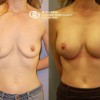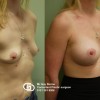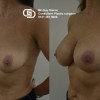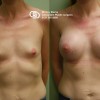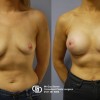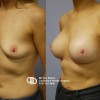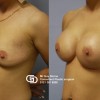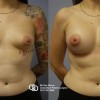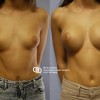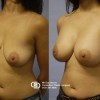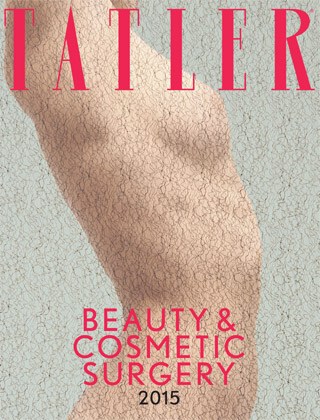Breast Enlargement
Breast Augmentation and Enlargement at my Birmingham practice
Breast enlargement is an operation whereby breasts are made larger by inserting an implant into them.
Our breast augementation in Birmingham is a good operation for women who:
- have never really had any breast tissue
- have had larger breasts at one time, but due to weight loss or childbirth have been left with small saggy breasts;
- are not happy with the shape of their breasts;
- simply would like bigger breasts.
What are implants made of?
There are two main types of breast implant:
1. Silicone Implants: consist of a silicone shell (outer wall) filled with silicone gel. The gel in modern silicone implants is thick, so that if the implant is cut or ruptured the gel stays together and does not run or leak everywhere. Silicone implants can be either round or teardrop shaped (see picture): 1. Round implants are a good choice if you already have enough breast tissue to give you a good breast shape. 2. Teardrop shaped implants are a good choice if you have very little breast tissue and you need the implant to shape your breast.
For more information on silicone implants in my Birmingham Clinic.
2. Saline Implants: consist of a silicone shell filled with saline (salt water). These gained popularity during the early 1990’s when there was a lot of misinformation regarding the safety of silicone implants (see below). However, they do not feel as realistic as silicone implants and have a tendency to leak slowly which results in a wrinkling of the silicone shell and visible ripples in the breast.
What size implants should I have?
The size of implants you receive is a very personal decision, but there are certain limitations that apply. As a general rule with breast augmentation, the bigger you go the more un-natural the appearance of the breast becomes. Some women opt for small, natural looking breasts whilst others prefer larger ones which may appear enhanced.
If you have never had much breast tissue, the skin of the breast is usually a limiting factor and will only stretch to accommodate a modest sized implant before starting to look enhanced, whilst if you have lost a lot of breast tissue (after breastfeeding or weight loss for example) you may need quite a large implant to restore shape and take up the slack. Alternatively, you may prefer to have a modest sized implant and combine this procedure with a surgical tightening of the skin (breast uplift).
We will decide upon the ideal implant for you together at the time of the first or second (free) consultation. You should bring with you a sports bra of the size that you aspire to fill. You will also need this sports bra after the operation to support your new breasts for comfort for the first few weeks after surgery. I would recommend that you buy either a Marks and Spencer’s sports bra (Impact factor 3) or a Berlei Shock Absorber (Impact factor 3). The chest girth will need to be the same as the bra that you usually wear, but the cup size will vary according to what you would like to be. For example, if you currently wear a 34A bra but wish to become a C Cup, you should bring a 34C sports bra with you to your initial consultation. I will then undertake measurements of your actual and ideal dimensions. You will then put on the sports bra and we will insert a range of implants of varying size until you find one that best gives you the figure you want. You can try to do this yourself at home by filling a freezer bag with dried rice until you get the shape and size you desire. The volume of rice in the bag can then be measured using a kitchen measuring jug.
How is the operation done?
From my private breast augmentation and enlargement surgery in Birmingham – under general anaesthetic, a small incision about 4cm long is made in the crease underneath the breast. A pocket is created either immediately behind the breast tissue or underneath the muscle behind the breast. This pocket is made using an electric scalpel which results in very little or no bleeding and minimises pain as the tissues are not unduly stretched or torn. The implant that has been chosen and agreed upon before the operation is then inserted into the pocket and the operating table adjusted so that you are sitting upright. This allows me to accurately determine the correct position of the implants and ensures the best shape and symmetry. I do not usually use drains but if there has been any bleeding or oozing from your breast tissue during the operation I will place a single drain which will emerge from your skin close to your armpit. The incision is then closed, using three layers of buried dissolvable stitches. The wound is then dressed and surgical tape is applied to accurately define the crease underneath your breast and to gently hold the implant downwards and towards the midline (as there is a natural tendency for the implant to move upwards and outwards until it has stuck to the overlying breast tissue).
Which incision is best?

A number of different scar positions have been proposed (see picture):
- Armpit: The incision can be made in the armpit, but this often results in an implant which sits to high, and there can be troublesome bleeding at the lowermost, innermost part of the breast, which is very difficult to see and control via an armpit incision.
- Around the Areola: The incision can also be made around the areola (the dark circle around the nipple). The problem with this approach is that nipple sensation may be affected and also, there are certain bacteria in and around the nipple which may cause capsular contracture around the implant.
- Belly Button: Implants can be inserted via a small incision around the belly button, however, only saline implants can be inserted with this method and again any troublesome bleeding is very difficult to control.
- Under the Breast: For these reasons, the incision in the crease beneath the breast is my preferred approach.
Which pocket position should I choose?
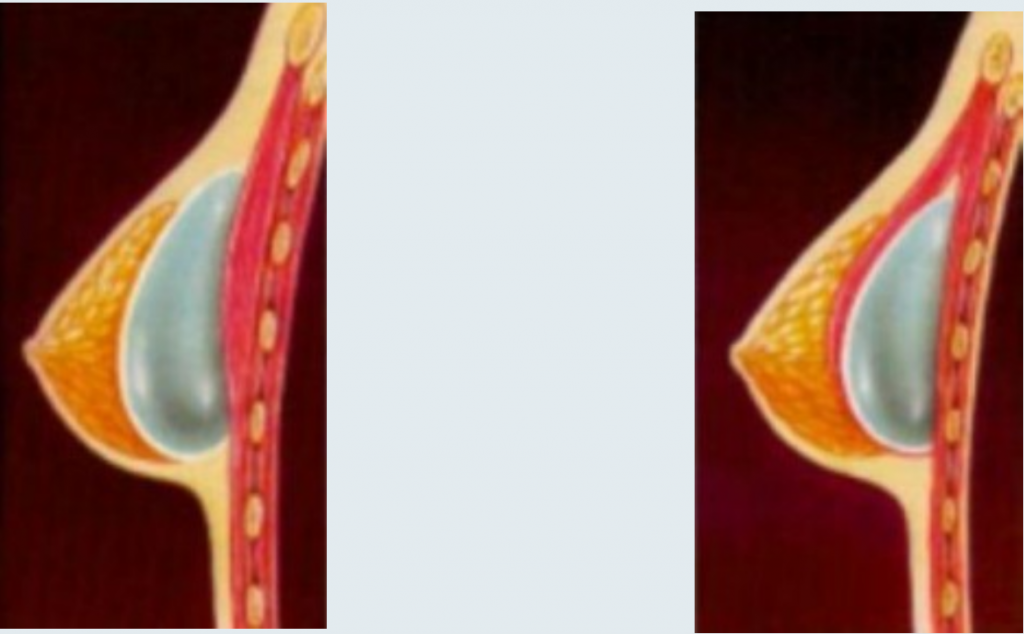
Sub-Glandular Sub-Muscular
- Sub-Glandular: Generally speaking a pocket beneath the breast puts the implant where the breast tissue usually is and results in a more natural appearance. However, if you have very little breast tissue over the implant the edge of the implant can be seen (especially in the upper cleavage area).
- Sub-Muscular: If you have very little breast tissue and do not want to see the edge of the implant it is best to put the implant under the pectoralis muscle. However, this approach is more painful as the muscle is stretched and the breast shape is a little less natural. Furthermore, the main disadvantage of sub-muscular pockets is that when the “pec” muscle contracts the implants may move or distort the breast shape as shown in these videos:
This video shows a small amount of movement with sub-muscular implants
This video shows quite a lot of movement with sub-muscular implants
This video shows a patient with submuscular implants demonstrating a wide cleavage and abnormal movement which also induces a double bubble deformity beneath the right breast
This is the same patient as above, but now larger implants have been inserted into a sub-glandular pocket eradicating the wide cleavage, double-bubble deformity and abnormal movement
Before and After Photographs
Sub-Glandular Pockets:


Sub-Muscular Pockets:

How long does the operation take?
Breast enlargement usually takes about 60-90 minutes
How many days in a Birmingham hospital?
Breast enlargement is usually done as a day case procedure i.e. you come to the hospital on the morning of surgery, undergo surgery and go home on the same day. However, some women prefer to stay in the hospital overnight and go home on the day after surgery. Furthermore, if a drain is required this will stay in place overnight and provided it has not produced too much fluid, the drain is removed the following morning and you may then go home.
Postoperative Period In Hospital
When you wake up you will have surgical tapes over your breasts. The operation causes a moderate amount of pain and discomfort and you will receive regular painkillers which should keep you comfortable. You should wear your sports bra before being discharged from a hospital.
Postoperative Follow Up
After discharge, you will be provided with written information to explain the postoperative course. An appointment will be made to see my Cosmetic Nurse one week after your operation. She will remove your dressings and inspect the wound, which should have healed nicely. You will be given advice on wound care, bathing and exercise advice.
You will be given an appointment to see me six weeks after your operation. At this appointment I will be checking on the early outcome of surgery; if all is settling satisfactorily I shall arrange to see you for a final visit six months later.
What are the possible risks?
All surgery carries the potential for complications. The specific complications that may occur with breast augmentation are:
- Capsular Contracture: When the implant is first placed into your breast, your body will recognise it as foreign and form a flimsy wall of scar around it to seal it off. Once it has done this your body will forget about it. You will not be able to feel this flimsy wall of the scar and it will not cause you any problems. Occasionally, however, something will irritate this wall of the scar and it will thicken and start to squeeze down on the implant. This will cause the implant to feel much firmer and to change shape and become round, like a tennis ball. As a result, your breast will become firm or even hard, change shape and may become uncomfortable. This is known as a capsule. Capsules happen in about one in twenty breast enlargements. They may occur as early as a few months after surgery or may develop many, many years after surgery. We do not know why capsules develop. They are treated by a further operation, to remove the implant and thick wall of the scar and replace it with another implant. Once you have had one capsule there is a slightly higher risk of developing another capsule around this new implant.
- Nipple Sensation: The breast enlargement procedure can stretch the nerves to the nipple and this can affect nipple sensation. Sixty percent of women experience some alteration in nipple sensation initially. Most of these will experience a reduction in nipple sensation, but a few will find their nipples become very sensitive and even clothes brushing against them will be unpleasant. This altered sensation mostly recovers to normal within six weeks, but about 8% will still have some altered nipple sensation at six months and for some women, this may be permanent.
- Breast Skin Numbness: In a similar way, some women will develop numb patches over the skin of part of their breasts. Again, this usually improves with time, but can occasionally be permanent. As the nerves begin to regain function you may notice occasional sharp shooting pains which could be described as being like a small electric shock. This is a good sign indicating nerve recovery and can continue for up to 18 months after surgery.
- Infection: Fortunately infection is rare with breast enlargement, but can cause swelling, redness and tenderness up to 3 weeks after surgery. This usually responds well to a course of antibiotics but very infrequently the infection can spread around the implant. If this happens, the implant may have to be removed completely and left out for several months until the infection is entirely eradicated before a new implant can then be inserted.
Once you have had breast enlargement it is a wise precaution to ask your dentist to give you antibiotics
before any proposed dental treatment
- Bleeding: Bleeding can occur at any time over the first ten days after surgery, and therefore it is wise to avoid any strenuous exercise over this time. Arm movements should be limited for the first week. Should a bleed occur into the breast, the breast can swell quite dramatically and you may develop visible bruising and tenderness. If this happens you usually need to return to theatre to have the blood removed and the bleeding stopped.
- Asymmetry: No two breasts are almost ever the same, and some degree of asymmetry is common both before and after this procedure and cannot be avoided, it is one of the limitations of any given pair of breasts. Great care is taken to ensure that the two breasts are as symmetrical as possible, but occasionally one or other implant may move slightly and create an unacceptable asymmetry. If this happens you will be advised on massage exercises to try and correct it, but ultimately you may have to return to theatre to have the implant relocated.
- Ugly Scarring: Although most scars settle very nicely to leave a pale flat line, occasionally scars may become red, raised, wide, itchy or ugly. This is very uncommon in breast enlargement and is determined more by a persons body tissue than by the surgery itself.
- Breast Feeding: The ability to breastfeed is not affected by having breast implants.
- Visible Implant: In very thin patients, despite placing the implant beneath the muscle behind the breast, the edge of the implant may still be noticeable beneath the skin.
- Visible Rippling: The shell of the implant may occasionally form rippling or folds. In the majority of women this will not be noticeable, but in thinner ladies, this rippling may be felt or even seen.
- Implant Rupture: The implants used are extremely durable and rupture due to direct pressure is extremely unlikely. There is a popular myth that ladies with breast implants cannot fly in aeroplanes because their implants may rupture. THIS IS NOT TRUE, it is perfectly safe to fly with your implants, though it is a wise precaution to avoid long-haul flights for about 3 months after surgery due to the slightly elevated risk of an economy class syndrome (also known as deep vein thrombosis) in the early postoperative period.
Is breast enlargement available on the NHS?
Generally speaking, breast enlargement is not, and should not be, available on the NHS. However, for a small number of women who have never developed any breast tissue; or who have one breast significantly smaller than the other; or who have severely misshapen breasts, it is possible to have breast implants inserted on the NHS.
Breast Augmentation and Enlargement in Birmingham with Guy Sterne.








